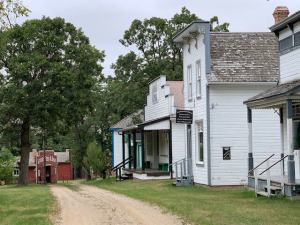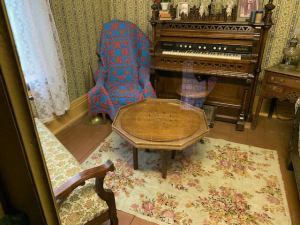
In 2021, Andrew and I visited the Manitoba Agricultural Museum in Austin, and I still haven’t told you about it!
I suppose the benefit of delaying a post is that now I’ve read Bill Redekop’s book Lake Agassiz: The Rise and Demise of the World’s Greatest Lake and I’ve learned a thing or two about the museum’s remarkable topography. In his book, Redekop chases Campbell Beach, which is our province’s fourth largest but most obvious paleolithic beach (“paleolithic” — is that the right word??)… and it leads him to visit the Manitoba Agricultural Museum. He says as he approaches the museum, there’s a definite 30-40 foot rise in the road.
Okay, so — the museum sits right on Campbell Beach! From what I recall of our time there, this makes perfect sense to me. Even though it’s been a minute, the overall impression stays with me:
First Andrew and I wandered past many many very old tractors. I wasn’t especially surprised by this, considering the whole Agricultural Museum thing… but the sheer volume of tractors that looked mostly the same (to me, a non-tractor-mechanic and also a non-farmer) did kind of weary me a little. (I’m sorry, is that bad to say? Honestly, I cannot pretend to be enraptured by fields of tractors.)

I was kinda trudging along after the miles and miles of tractors (disclaimer: not actually miles, it just felt like it) when a path came into my sightline.

The path had two graveled wheel tracks and led up a hill into the woods. I followed the path and discovered a village in the woods on the hill!

Whaaat?! The Manitoba Agricultural Museum has a village in the woods!?!! Why did I not know this? Do they tell people about this? I think that it is very VERY cool.

Here are some (but not all) of the things we encountered:

A cairn and a sign! The cairn’s “headline” or whatever says “Fort Ellice Edmonton Trail 1821-1879”.
There’s some language on that cairn that I’m not entirely comfortable with. Meaning, the glorification of the settlers and pioneers and “nation-building”. I don’t love that. But I was interested to learn that, well, it seems like this path through the village (along paleolithic Campbell Beach, no less) was a historic trail. I guess that makes sense — as trails mostly followed these ancient beach ridges which rose out of the water during spring melt. I feel like this trail was established prior to 1821, though. I mean, from what I’ve read, and what makes sense to me, is that these trails were already here when Europeans got here — these trails were established by Indigenous people. That’s what I think. But I don’t have any sources to cite on this. I can never remember where I read things, and I apologize for that. (Though I think I have read this in numerous places…?)
The sign next to the cairn, is fascinating! It says: “Fort Ellice – Edmonton Trail. The history of this Agricultural Museum is added to by a trail cutting across its land. This trail was known as the Fort Ellice – Edmonton Trail, or the Saskatchewan Road as shown on the map. Your destination determined what you called the trail you were travelling on. This trail cuts across the museum grounds at a point where the parade passes the grandstand during the annual Manitoba Threshermen’s Reunion and Stampede and then across Highway 34 in a northwesterly direction to the Squirrel Creek crossing. Here had been McKinnon’s toll bridge and a stopping house. And a little farther on was a cemetery. The number of graves in this cemetery indicated that this trail had been much travelled.”
Next time I’m in the neighbourhood I’ll have to look for that cemetery. (I think it’s probably different from the current Austin Cemetery…?)

The village includes a couple of log buildings as well, and inside we found a crokinole board! Andrew had to take a picture:

This below CPR water tower was built in 1904!

The sign below says “Dave Zacharias Memorial Arena” so Andrew took a picture of it too because it sounds Mennonite. 😀

What else did we see? Well, this picture reminded us of Niverville so we zoomed in for a closer look.

If you’ve been to Niverville in the last few years, you may have noticed they’ve adopted that round-style grain elevator as their town’s symbol and it’s everywhere. There’s a good reason for that, and the little writeup will tell you exactly why:
“The first grain elevator in Manitoba. In 1877, William Hespeler bought the SW quarter of 31-7-4E from Abraham Friesen for $166.10. In 1878, he bought about 30 acres off the north side of the NW quarter of 30-7-4E. In the summer of 1878, he had 80 acres surveyed as the Niverville townsite. In 1879, he financed and had built an elevator of 25,000 bushels capacity and a hotel. In 1880 he sold the hotel to Erdman Penner and the elevator to John Macara. The construction foreman and head carpenter to build the elevator was John Wittick. After completion of the elevator he was the grain buyer for the next 12 years. The elevator was not used after 1904. It was dismantled by Hilaire Robidoux of Otterburne. He built a large barn out of the lumber. It was used to house livestock for many years and is in use by his grandson as an implement shed in 1990.”
I guess that was written in 1990. Wonder what the update would say. Also, it’s interesting to me that this bit of history has found its way from Niverville to Austin! I mean, it’s only a two-hour drive… yet at the same time, it’s a two-hour drive! With any museum-y places in-between.
Well, all I have to say is that we had a lot of fun investigating the Manitoba Agricultural Museum!

I think THIS is why people should come to this museum. Never mind the tractors — its village is fantastic! (I mean that’s great if you love tractors, and I think little kids would love the tractors a lot too) but I love that the village is kind of hidden in the woods, on a hill — it’s all so very unexpected!
But, I should’ve known. I mean, the Manitoba Agricultural Museum is a Manitoba Signature Museum for a reason!
(Hey did you know Mennotoba is on Instagram? It’s true! Find us at @realmennotoba — I’m going to post more pictures from the Manitoba Ag Museum there. WordPress is great and all but it’s not an ideal spot for a bunch of pictures. But Instagram is! *cue me hurrying off to post on IG*)

